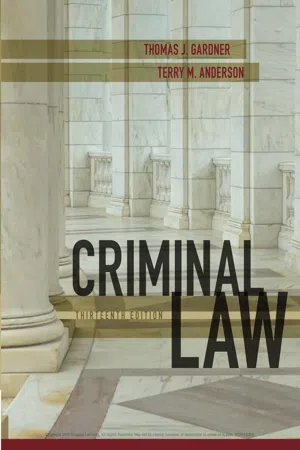Law
Aggravated Assault
Aggravated assault is a serious form of assault that involves the intentional infliction of severe bodily harm or the use of a deadly weapon. It is typically considered a felony and carries harsher penalties than simple assault. Factors such as the severity of the injury, the use of a weapon, and the status of the victim can all contribute to an assault being classified as aggravated.
Written by Perlego with AI-assistance
Related key terms
1 of 5
6 Key excerpts on "Aggravated Assault"
- eBook - PDF
- Charles P. Nemeth(Author)
- 2011(Publication Date)
- Routledge(Publisher)
“Aggravated” means that the inflic-tion is more than the garden variety of push and shove and results in significant injury. To find aggravation, one must evaluate both the mind of the actor, who specifically intends the out-come, and the means or instrumentality utilized to reach the desired end. A major felony with extraordinary penalties attached, Aggravated Assault inhabits territory closely aligned to feloni-ous homicide because the means to kill accompany the assaulter. The means do not necessarily translate into the specific intent to kill, but can impute a lower form of homicidal intent if death occurs. This is why the offense is viewed as seriously as it is. A cursory look at any statute will contain these types of qualifications: • That the actor acts with extreme indifference to human life • That the actor offends knowingly, intentionally, and recklessly • That the actor offends using a weapon or other instrumentality • That the actor targets special victims, such as teachers, EMS, and police The Model Penal Code delivers a crystal clear picture of how this offense differs from assault. A person is guilty of Aggravated Assault if he: (a) attempts to cause serious bodily injury to another, or causes such injury purposely, knowingly or recklessly under circumstances manifesting extreme indifference to the value of human life; or (b) attempts to cause or purposely or knowingly causes bodily injury to another with a deadly weapon. 43 The crux of the offense is its pure and unadulterated intentionality. There is no mistaking the mindset of the accused for he or she cannot offer up alternative explanations for why they Crimes Involving Bodily Injury 219 CASE 5.4 STATE V. HUMPHRIES 21 Wash. App. 405, 586 P.2d 130 (1978). On the evening of January 17, 1977, Seattle police officers responded to a radio call seeking to locate defendant Humphries concerning some traffic and robbery warrants. - eBook - PDF
A Pattern of Violence
How the Law Classifies Crimes and What It Means for Justice
- David A. Sklansky, David Alan Sklansky(Authors)
- 2021(Publication Date)
- Belknap Press(Publisher)
57 The line between simple assault and Aggravated Assault is hazy, though. In Wyoming, as in most states, an assault can be aggravated by the use of a dangerous or deadly weapon, or by causing “serious bodily injury,” intentionally or with great recklessness. (An assault and battery is also aggravated in Wyoming if the offender knows the victim is pregnant; 72 · A P AT T E R N O F V I O L E N C E Florida has a similar provision.) The FBI uses a similar rule for deciding whether an assault reported to the police should be viewed as “aggra- vated” and therefore included in the violent crime statistics produced by its Uniform Crime Reports program. The FBI calls an assault aggra- vated if it involves a weapon or causes “obvious severe or aggravated bodily injury.” 58 The trick is defining a “weapon,” or a “dangerous” or “deadly” weapon, and deciding what injuries count as “serious.” In some states, hands and other body parts can be “deadly weapons”; in other states they cannot. Sometimes dogs are classified as “deadly weapons”; sometimes they are categorically excluded. Ditto for canes, walking sticks, and other ev- eryday objects used as bludgeons. The rapper and music producer Sean “P. Diddy” Combs was arrested in 2015 for Aggravated Assault after an- grily waving a kettlebell during an argument in a college gym, although the charges were dropped. Some courts say that bare feet cannot be clas- sified as “deadly” or “dangerous weapons,” but that kicking or stomping can qualify as Aggravated Assault if the assailant is wearing shoes or sneakers. 59 There is even more ambiguity about what constitutes a “serious bodily injury.” For purposes of the Uniform Crime Reports, the FBI says that injury cannot count as “severe or aggravated” unless it involves “broken bones, loss of teeth, possible internal injury, severe laceration, or loss of consciousness.” But the courts of some states define “serious bodily in- jury” to mean any injury that is “graver and more serious . - eBook - ePub
Violence in American Society
An Encyclopedia of Trends, Problems, and Perspectives [2 volumes]
- Chris Richardson(Author)
- 2020(Publication Date)
- ABC-CLIO(Publisher)
Assault and BatteryIn 2018, law enforcement agencies from around the United States reported a total 814,644 incidents of Aggravated Assault, accounting for 65 percent of all violent crime reported the previous year (Federal Bureau of Investigation 2018). Yet despite being the most commonly reported act of violence in the United States, assault—aggravated or otherwise—is among the more vaguely defined criminal acts one can commit. In fact, when one imagines a person committing assault, it is entirely possible that what one imagines is not assault at all, but the closely related act of battery. Moreover, unlike other types of violent crime, assault and battery are ubiquitous in nearly every form of media from children’s stories and cartoons to popular music, video games, and every genre of film.Although it lacks a universal legal definition, contemporary American understandings of assault can be traced back to British common law (a law based on judicial precedent rather than statutes), in which it is described as “an attempt, with violence, to do corporal injury to another … As by striking … or any other act done in an angry manner” (Hawkins and Leach 1788, 621). In the event the attempt at injury is successful, the offending individual has committed battery, which was defined in common law as “any injury actually done to the person of another; as spitting in his face; treading on his shoes; [or] jostling him in a revengeful manner” (ibid.). In simple terms, assault can be generally understood as a threat or attempt to cause physical harm to another person, regardless of whether that attempt is successful, whereas battery is the act of causing harm. In this definition, every act of battery will necessarily include assault, but not every assault will include battery. For instance, if one convincingly threatens to cause physical harm to another but does not follow through with the threat, one has only committed assault. - eBook - PDF
- Thomas Gardner, Terry Anderson(Authors)
- 2017(Publication Date)
- Cengage Learning EMEA(Publisher)
The defendant before you was charged with Aggravated Assault and tried before you in a bench trial. The charge was based on the following agreed facts: Defendant was seated in the passenger seat of a police cruiser after his car was stopped for a traffic offense. One officer, the victim of the assault, was seated in the driver’s seat, and the other officer was outside the police cruiser. Without warning, defendant began striking the victim in the face, and did so several times before the other officer entered the cruiser and subdued him. The victim was not seriously injured, but did require medical attention to his injuries. A t the close of the prosecution’s case the defendant moved for a judgment of acquittal, contending the state failed to prove he caused serious bodily injury, or if he did, that the circumstances manifested extreme indifference to the value of human life. The assault statute in your state defines Aggravated Assault as an assault by a per - son who: “ A “ “ ttempts to cause serious bodily injury to another, or causes such injury, under circumstances manifesting extreme indifference to the value of human life.” The statute does not define “circumstances manifesting extreme indifference.” De - fendant contends (1) he did not seriously injure the victim; (2) that the state did not prove he acted intentionally or knowingly to take the victim’s life; and (3) “extreme indifference” applies only when the injuries posed a threat to the victim’s life, which these did not. YOU BE THE JUDGE Should you grant the defendant’s motion? See State v. Miland , 858 N.W.2d 328 (S.D. 2014) mayhem and malicious disfigurement Willfully inflicting an injury on another so as to cripple or mutilate the person. Copyright 2018 Cengage Learning. All Rights Reserved. May not be copied, scanned, or duplicated, in whole or in part. WCN 02-300 - eBook - PDF
- Joel Samaha(Author)
- 2016(Publication Date)
- Cengage Learning EMEA(Publisher)
So in attempted battery assault, a victim’s awareness doesn’t matter; in threatened bat- tery assault, it’s indispensable. The MPC deals with threatened and attempted battery assaults as follows: § 211.1 Simple Assault A person is guilty of assault if he:attempts to cause . . . bodily injury to another; or attempts by physical menace to put another in fear of imminent serious bodily harm. Simple assault is a misdemeanor unless committed in a fight or scuffle entered into by mutual consent, in which case the assault is a petty misdemeanor (ALI 1985). Historically, all assaults were misdemeanors. However, modern statutes have cre- ated several aggravated or felonious assaults. Most common are assaults with the intent to commit violent felonies (murder, rape, and robbery, for example), assaults with deadly weapons (such as guns and knives), and assaults on police officers. The MPC includes a comprehensive assault and battery statute that integrates, rationalizes, and grades assault and battery. It takes into account actus reus, mens rea, circumstance elements, and intended harm. Note the careful attention paid to these elements: § 211.2 A person is guilty of Aggravated Assault if he: a. attempts to cause serious bodily injury to another, or causes such injury purposely, knowingly or recklessly under circumstances manifesting extreme indifference to the value of human life; or b. attempts to cause or purposely or knowingly causes bodily injury to another with a deadly weapon. Aggravated Assault under paragraph (a) is a felony of the second degree; aggra- vated assault under paragraph (b) is a felony of the third degree. § 211.3 A person commits a misdemeanor if he recklessly engages in conduct which places or may place another person in danger of death or serious bodily injury. Reckless- ness and danger shall be presumed where a person knowingly points a firearm at or in the direction of another, whether or not the actor believed the firearm to be loaded. - eBook - ePub
- Tony Storey, Alan Lidbury(Authors)
- 2012(Publication Date)
- Willan(Publisher)
Fagan).- Battery is also an offence under s.39 CJA. It is defined as the intentional or reckless application of force to another person (Fagan).
- Assault occasioning actual bodily harm (ABH) is an offence contrary to s.47 of the Offences Against the Person Act 1861 (OAPA).
- Wounding or inflicting grievous bodily harm (GBH) are offences contrary to s.20 OAPA.
- Wounding or causing GBH with intent to do GBH or with intent to resist arrest are offences contrary to s.18 OAPA. There is no offence of wounding with intent to wound (Taylor).
- For an assault, although V must apprehend ‘immediate’ force, it is sufficient if V does not know what D is going to do next (Smith v Superintendent of Woking Police Station; Ireland; Constanza).
- Assault may be committed by words alone, whether spoken (Ireland) or written (Constanza). But words may also negative assault (Tuberville v Savage).
- ABH has a wide meaning (Donovan; Chan-Fook). It includes psychiatric injury (Chan-Fook; Ireland).
- Wounding means that the continuity of the skin must be broken (Moriarty v Brookes). Purely internal bleeding is not a ‘wound’ (JCC [a minor] v Eisenhower).
- GBH means really serious harm (DPP v Smith [1961]) or just serious harm (Saunders). It includes psychiatric injury (Burstow) but psychological harm does not suffice (Dhaliwal). The transmission of a serious disease through sexual intercourse can lead to liability for inflicting ‘biological’ GBH (Dica; Konzani
Index pages curate the most relevant extracts from our library of academic textbooks. They’ve been created using an in-house natural language model (NLM), each adding context and meaning to key research topics.





